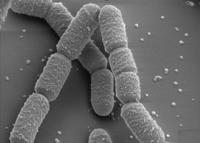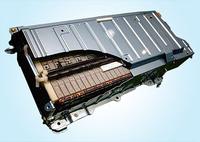-
Microstructural improvements enhance material properties
DARPA merges structural engineering principles with new fabrication technologies to demonstrate microstructural control of materials at the micron level; the ultimate objective of the agency’s Materials with Controlled Microstructural Architecture (MCMA) program is to be able to develop materials in the future with properties tailored to meet specific mission requirements
-
-
Quick-curing concrete for infrastructure, mining disaster recovery
A quick-curing concrete can be sprayed to reinforce structures — buildings, runways, tunnels, bridges, dams – damaged by an act of terror or natural disaster; the spraying can be done almost immediately, before the structure fails catastrophically, providing safety for rescue workers who risk their lives minutes after disasters hit, and for still stranded in or near the damaged structure
-
-
Ancient design concept leads to new ideas for building durable bridges

Engineers combine an ancient concrete arch form, dating back to the Roman empire, with a composite shell to create bridge beams which are designed to last 100 years
-
-
Using nanomaterials to build safer, longer-lasting roadways
Asphalt is now made from petroleum, so it is very expensive; researchers tested two types of nanoclays, adding 2-4 percent by weight to asphalt; this is a smidgeon — less than half of a percent of the total weight of the asphalt pavement itself, but it made a big difference, and could make for safer, longer-lasting roadways
-
-
Humble bacteria help create self-healing concrete

Scientists use a ground-borne bacteria — bacilli megaterium — to create calcite, a crystalline form of natural calcium carbonate; this can then be used to block the concrete’s pores, keeping out water and other damaging substances to prolong the life of the concrete
-
-
Honda to reuse rare Earth metals from used parts

Rare Earth elements are essential to advanced technological application and to green technology products; China controls 97 percent of the world’s production of these elements, and has been using its near-monopoly to hobble non-Chinese companies and for political blackmail; in response, two Japanese companies announce a new process allowing them to extract as much as 80 percent or more of rare Earth metals contained in used nickel-metal hydride batteries
-
-
Some flame retardants make fires more lethal
Almost 10,000 deaths from fires occur in industrialized countries worldwide each year, including about 3,500 in the United States; scientists find that widely used flame retardants added to carpets, furniture upholstery, plastics, crib mattresses, car, and airline seats and other products to suppress the visible flames in fires are actually increasing the danger of invisible toxic gases that are the No. 1 cause of death in fires
-
-
New plastics mimic human skin: they “bleed” when scratched, then heal
Plastics have become so common, replacing steel, aluminum, glass, paper, and other traditional materials because they combine desirable properties such as strength, light weight, and corrosion resistance; a new genre of plastics that mimic the human skin’s ability to heal scratches and cuts offers the promise of endowing military and first response gear – and consumer goods – with self-repairing surfaces
-
-
U.S. files trade charges against China over rare minerals

China mines and sells about 97 percent of the world’s rare Earth elements – seventeen metals used in cell phones, advanced batteries, wind turbines, and more; the Chinese, in violation of WTO rules, have manipulated the export of these minerals in order to weaken the techno logy sectors of other countries, and punish countries over political disputes
-
-
New material for sustainable road building: "poticrete"
An organization dedicated to promoting sustainable roadway construction, awarded its first official certification to a Bellingham, Washington, project that incorporates porcelain from recycled toilets; a newly widened sidewalk in Bellingham incorporates more than 400 recycled toilets, crushed into what the project engineers have dubbed “poticrete”
-
-
Shift to green energy could mean crunch in rare Earth metals supply
A large-scale shift from coal-fired electric power plants and gasoline-fueled cars to wind turbines and electric vehicles could increase demand for two already-scarce metals — available almost exclusively in China — by 600-2,600 percent over the next twenty-five years
-
-
Recycled glass in cement makes concrete stronger
Researchers have found that by mixing ground waste glass into the cement that is used to make concrete, the concrete is stronger, more durable, and more resistant to water; in addition, the use of glass helps reduce the amount of glass that ends up in landfills
-
-
New methodology evaluates risk of scarce metals
China produces more than 95 of the world’s rare Earth metals, making governments and businesses around the world uneasy; researchers develop a methodology ti answer two important questions: how do we know what is scarce? If we know a metal is scarce, how do we know whether we should worry about it?
-
-
The strength of a spider web depends on design, not only on silk

New study shows that spider web’s durability depends not only on silk strength, but on how the overall web design compensates for damage and the response of individual strands to continuously varying stresses
-
-
Digital images used to prevent bridge failures
A new/old method has been developed to assure the safety of hundreds of truss bridges across the United States; researchers have been testing the use of a thoroughly modern version of an old technique — photographic measurement or “photogrammetry” — to watch the failure of a key bridge component in exquisite detail
-
- All
- Regional
- Water
- Biometrics
- Borders/Immig
- Business
- Cybersecurity
- Detection
- Disasters
- Government
- Infrastructure
- International
- Public health
- Public Safety
- Communication interoperabillity
- Emergency services
- Emergency medical services
- Fire
- First response
- IEDs
- Law Enforcement
- Law Enforcement Technology
- Military technology
- Nonlethal weapons
- Nuclear weapons
- Personal protection equipment
- Police
- Notification /alert systems
- Situational awareness
- Weapons systems
- Sci-Tech
- Sector Reports
- Surveillance
- Transportation
Advertising & Marketing: advertise@newswirepubs.com
Editorial: editor@newswirepubs.com
General: info@newswirepubs.com
2010-2011 © News Wire Publications, LLC News Wire Publications, LLC
220 Old Country Road | Suite 200 | Mineola | New York | 11501
Permissions and Policies
Editorial: editor@newswirepubs.com
General: info@newswirepubs.com
2010-2011 © News Wire Publications, LLC News Wire Publications, LLC
220 Old Country Road | Suite 200 | Mineola | New York | 11501
Permissions and Policies
